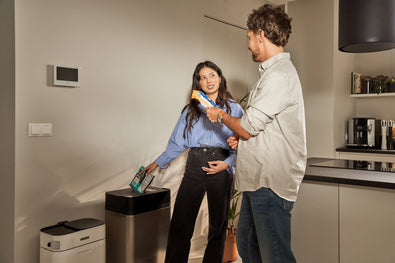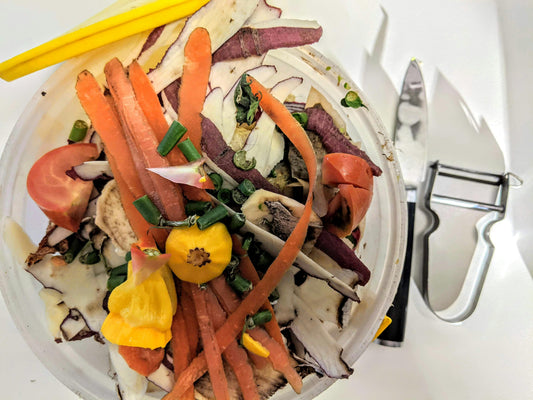ZeroTrash® Revolution Blog Blog
Explore articles on recycling, waste management and sustainable habits by category

Clear Drop: how we’re revolutionizing home waste management
Read
Clear Drop: how we’re revolutionizing home wast...
What if managing household waste was not a burden, but the easiest and most natural thing you do at home? And what if all our waste was actually processed? That’s...
CompostKitchenSoft plasticWaste management
Clear Drop: how we’re revolutionizing home waste management
What if managing household waste was not a burden, but the easiest and most natural thing you do at home? And what if all our waste was actually processed? That’s the question we are addressing at Clear Drop® trying to find innovative solutions for waste reduction in landfills coming from households. We believe that real environmental change starts not with complicated recycling systems, but with smart, seamless solutions. That’s why we’re pioneering the future of pre-recycling: a simple, effective way to prepare waste for recycling right where it’s created with the help of our home appliances. From tricky soft plastic packaging to everyday food scraps, we’re transforming how homes handle waste - and helping people move closer to a Zero-Trash lifestyle. What is more important, we create a system where your soft plastic waste is processed with our partner network of recycling facilities and your organic waste is stored in the way it can still enrich the soil. Why Clear Drop? Clear Drop is a symbol of the neutral impact of humankind on nature. It is a metaphor for what remains after human consumption. Every day we as humans consume food and buy many products in packaging. It results in waste - plastic packaging, empty bottles, paper, glass, cans, organic waste etc. While only a marginal part of that is truly recycled, the footprint of human consumption is very high. The goal of Clear Drop is to reduce this footprint to a single clear drop. A new concept of pre-recycling Pre-recycling is the approach that meets current challenges where the recycling system can’t deal with all types of waste we generate. Pre-recycling means preparing waste for its further efficient recycling before it is dropped into the recycling bin. Currently, some materials tackled by Clear Drop’s home appliances are literally not recycled as soft plastic, not being collected conveniently enough. The regular recycling process is often ineffective: trucks “transporting air”, and labor-intensive separation - together they consume a lot of energy, and resources and create pollution of their own. With pre-recycling, discarded items are conveniently separated and prepared for recycling on the spot facilitating waste reduction. Further on - the material is prepared for storing at home and further delivery to the recycling facilities of our partners. It is cleaner, denser, more convenient for transporting and all-around more manageable for further processing. Moreover, we guarantee recycling. The actual problems we address Challenging soft plastic waste An estimated five trillion plastic bags are used annually worldwide, not including numbers of film packaging and other types of soft plastic. Only 1% of households can recycle film at home today. Less than 10% of soft plastic is recycled, and the data is still not always being calculated and reported. Unlike some traditionally recyclable commodities, such as PET bottles or HDPE bottles, there is not very much publicly available information on the generation and composition of film and flexible packaging.Soft plastic is perceived as a barrier to the efficient process of recycling other types of plastic while being put together in a blue bin for recycling (link to the previous blog post). Soft plastics are lightweight, flexible and inexpensive to produce. This has made them popular choices for packaging. But this ignores the problems of disposal, including harm to nature and people when it ends up in landfills. Unless it’s compacted in a solid substance that changes the process of processing, soft plastics can get tangled or stuck in machinery at recycling or waste-processing facilities, causing inefficiencies and disruptions in the process. Clear Drop solution: compacting soft plastic waste Clear Drop offers the first step in solving this problem – business and home appliances that can prepare soft plastic waste for further transportation and actual recycling. Soft Plastic Compactor (SPC) significantly simplifies the soft plastic collection and transforms fluffy packaging into a shape-preserving 12 × 8 × 4-inch block. It happens with the help of a patented plastic surface-softening technology to keep soft plastic compacted for storage and transportation that is safe for users and the environment. SPC accepts all major types of soft plastic packaging (excluding PVC and PS which are dangerous by nature) like food wrappers, soft plastic containers, shopping bags, cling film, and other types of packaging from your purchases.The device stores around one month of soft plastic waste and provides low energy consumption. The soft plastic prepared by the SPC is easy to pick up and transport, making it more manageable than any other option. The soft plastic block can be emailed to Clear Drop. We offer end-2-end service in collaboration with our recycling partners which adds more possibilities to soft plastic waste reduction in landfills. Dealing with the consequences of organic waste Organic waste is just as harmful to the environment as plastic if it ends up in landfills instead of being composted. When compostable materials, like food scraps and yard waste, are thrown in with regular trash, they end up in landfills. These materials could have been repurposed into nutrient-rich compost to enrich the soil and contribute to waste reducion, but instead, they take up valuable landfill space and contribute to 11% of the world’s greenhouse gas emissions. In landfills, organic waste decomposes anaerobically (without oxygen), producing methane, a potent greenhouse gas. Methane is approximately 25 times more effective than carbon dioxide at trapping heat in the atmosphere, contributing significantly to climate change. Organic waste in landfills contributes to the production of leachate – a toxic liquid that can seep into the ground, potentially contaminating soil and water sources. Composting not only recycles nutrients but also helps sequester carbon in the soil, reducing atmospheric carbon dioxide levels. Without composting, this potential benefit is lost. Organics Collector: new technology to close the loop for organic waste To not let organic waste end up in a landfill people don’t need to do composting by themselves to support waste reduction. Clear Drop makes collecting organic waste at home convenient uninterrupted and without an unpleasant smell, leaks, dissolving organic bags, flies or the necessity to frequently empty the bin with one more home appliances, Organics Collector. Organics Collector (OC) stores and gradually accumulates food waste for several days up to one week. At the same time, the device helps to avoid the appearance of unpleasant odors and insects. Featuring non-energy-intensive processes, the OC consumes very little energy. The unique combination of the O3 generator and filtration system makes sure unpleasant smell is eliminated. Additionally, while stored, the organics in OC undergo a dehumidification process, reducing their moisture content by 30–40%. This makes all OC-collected material easier to transport and pick up and preserves composting features of the material. Once the bin is full, the dried organics can be disposed of at a municipal waste collection point or go to your local or community compost pit. Clear Drop® Founder's Message ‘These are just the first two systems we’re bringing to market. The problem is massive, and Pre-recycling is still in its infancy. But many more solutions are coming. Our promise to the world is that everything processed by our appliances will be recycled — if disposed of properly. We wouldn’t do this if we couldn’t make a difference. Let’s work together to make our future look like a hopeful science fiction story — not the bleak dystopias we risk if we don’t change our approach to waste management.’ Ivan Arbouzov, Founder & CEO of Clear Drop®

Composting: electric vs. professional or tradit...
According to the U.S. Environmental Protection Agency, "only about 5% of the annual 66.2 million tons of food waste is composted", which leads to landfill overfilling and emissions of methane. The...
CompostDisposalOrganic waste
Composting: electric vs. professional or traditional options
According to the U.S. Environmental Protection Agency, "only about 5% of the annual 66.2 million tons of food waste is composted", which leads to landfill overfilling and emissions of methane. The rising environmental needs for composting and new legislations in separating organic waste for households create a new market for solutions and home appliances. This market for various devices for composting or preparing food scraps to compost-like material is already overcrowded by different technologies. Here also comes electric composters, which have become a separate category, and are being introduced by more and more brands these days. They claim to conveniently convert organic household waste into plant food or soil amendments without unpleasant odors or pests. But do they really make compost that can enrich the soil and introduce a genuine solution, or is it a misleading trend? This is a point that has been questioned by many environmental experts and gardeners. Let’s look at the facts! How do electric composters work? The features of electrical composters may vary from the producer, but the general logic of their work stays the same. Basically, all of them use heat, grinding, and aeration technologies inside the devices to dehydrate and grind up organic waste. They get rid of bacteria and pathogens while heating your organics to a high temperature, depending on the model, to about 160°F or over 212°F. During the heating process, the device starts to grind your food scraps into small pieces into dry brown powder or chunky and fibrous material, depending on what waste you have. The rotation of the material and charcoal filter simulates compost aeration and helps to prevent odors. This process takes a few hours and reduces the volume of your organic waste to 70-90%. That sounds perfect for keeping your kitchen odor-free and pest-free, but suspicious about fully dehydrated and ground material being used as a compost that usually needs microbial decomposition and compost bacteria for benefiting the soil. The composting misconception Despite marketing claims, the material that is the final product of electric composters’ work is not one that can be called compost and doesn’t have the same ‘composting magic’ features to help plants grow better and contribute to soil health. Even naming it differently can’t guarantee good output for the soil, as it’s declared by electric composters’ brands. “Right from the moment that I saw the first unit, I questioned the 'composting' aspect. How can they compost so quickly when composting is a very slow process?” – said Robert Pavlis, an educator, gardener, blogger, writer and chemist, in an interview with GardenMyths.com. As stated by the U.S. Environmental Protection Agency, the output from these devices is more accurately described as "dehydrated food waste byproduct" rather than compost. This material is not biologically stable and often requires further decomposition before it can be safely and effectively used in soil. Applying it directly to plants may not grant the intended benefits to soil health and could potentially harm plant health due to incomplete decomposition and possible high salt content. Some of the tests of environmentalists challenge the statements of electric composter producers, showing that the final material could be detrimental to plant growth and does not eliminate the odor of food scraps, which can attract pests. As outlined by horticulturist Ron Alexander, "it’s not only the missing bacteria that may be problematic, as the freshly ground material can contain concentrated levels of certain nutrients and salts that, when added to garden beds, create an imbalance in the soil's nutrient profile". It may also heat up during the decomposition process, harming plant growth. In addition, the organic waste could become moldy or attract pests if immediately used in the garden. In cities where composting options are limited, such devices provide a practical way to separate food scraps. But since they don’t make a real compost, meaningful progress in reducing food trash and proper composting requires a professional approach and participation of municipal systems. Professional composting: a sustainable alternative Unlike electric devices that grind and dry organic waste without microbial action, professional composting systems rely on natural decomposition to produce true compost.Professional composting, as understood by the US Composting Council, involves large-scale, controlled composting processes that handles significant volumes of organic waste and ensures rapid decomposition under managed conditions. What are these conditions, and why can they process organic waste more efficiently than home setups? The professional composting process entails the following steps: aerobic decomposition with oxygen; strictly controlled temperature, humidity, and airflow levels conditions; the use of microorganisms and sometimes mechanical turning or forced aeration to speed up the composting process. One of the main differences between professional and home composting is time. A professional composting service will create the ideal conditions for the breakdown of organic waste into efficient compost, supporting soil health. Another key difference is in the variety of waste that can be composted. Professional composters can handle a much wider range of organics, including things like bioplastics and bones, that can’t be processed in domestic outdoor or indoor compost bins. Alternatives as part of the solution For those seeking to make a meaningful contribution to sustainability, engaging with professional composting services or traditional composting methods is advisable. By supporting systems that produce genuine compost, individuals can enhance soil health, reduce greenhouse gas emissions, and participate in a more sustainable waste management cycle. At the same time, there are other solutions for those households for whom doing a traditional compost is not an option and coping with flies, leaks, and odors is a mission. At Clear Drop, we investigated the current issues with organic household waste management and solutions with their benefits and drawbacks to introduce our own technology. We created a kitchen appliance, Organics Collector, that solves the challenge of convenient household organic waste management without full dehydration.Suppression of your organic waste is carried out using a combination of 3 technologies: dry without heating, aeration, and ozone treatment. Drying reduces the moisture content of your food scraps and other organic waste by only 30-40%, which is still preserves the essential organic matter, allowing it to be effectively composted in industrial facilities or in your own or community pit. Aeration is the process of saturating the waste mass with air. Ozonation - regular treatment of the contents of the container with limited and safe doses of ozone. Additional protection for the consumer from unpleasant odors is carbon-filter adsorption. With its help, all air coming out of the device is filtered and cleaned. While electric composters offer convenience, they fall short of delivering true compost or contributing meaningfully to soil health. Real sustainability lies in supporting systems that return nutrients to the earth through natural decomposition. Whether by engaging with municipal composting services or exploring home methods rooted in biology, the smarter path is one that nurtures soil, not just simplifies disposal. In tackling organic waste, we need solutions that close the loop - not just reduce volume.

